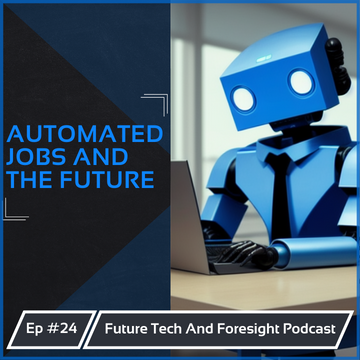About The Episode
The second last monologue based episode that looks back and summarises the main ideas presented in this podcast, technologies explored, and solutions proposed.
Transcript
Intro
So….this episode and the next will be the last two monologue format episodes for automated. As I said all the way back at the start, I wanted to lay out the foundational ideas connected to automation, before starting interesting discussions with experts to dive more deeply into these topics.
Now that being said, with the coronavirus outbreak some modifications have had to be had with the podcast. Rather than focusing on automation in general, the first series of interviews will have a heavy slant towards how this pandemic is impacting different sectors and technologies, but of course also focus on automation and jobs. I have already done a few interviews and I’m excited about sharing them with all of you in the next few weeks.
I do however want to finish with these last two episodes as they encapsulate the ideas presented in the podcast so far as well as set up the frame for the series of interviews that will come afterwards, while also giving a small break to the constant flow of virus pandemic focused ideas which I think all of us are overly saturated with. I will also skip the usual technology update section as I am planning on writing a comprehensive article which assembles all of the main technological, automation and job related impacts the global crisis is pushing forward, as a more substantial follow up to the coronavirus special episode I did a few weeks back.
So with that out of the way, this episode will summarize the main thread that has been kept throughout the episodes up till now.
Two future perspectives
Regarding the future of technology and the ability to automate human tasks and entire jobs there are two dominant positions that people have held over time. The historical perspective which falls in line with the idea of creative destruction, and the perspective that rose from the Luddite movement in the 1800s, that of technological unemployment.
Augmentation (short term) leading to Technological unemployment (long term)
A 2014 questionnaire by the PEW Research Centre had 2000 well known experts in the field of technology questioned on which side of this argument they fell on. The Chief scientists of salesforce.com, vice president of Google, and the Principle researcher for Microsoft were among those interviewed. “48% of all the experts, envisioned a future of technological unemployment in which robots and digital agents have displaced significant numbers of both blue- and white-collar workers—with many expressing concern that this will lead to vast increases in income inequality, masses of people who are effectively unemployable, and breakdowns in the social order.
Creative destruction. With augmentation
While 52% expected a future of continuous creative destruction where technology will not displace more jobs than it creates by 2025. This group anticipated that many jobs currently performed by humans will be substantially taken over by robots or digital agents by 2025. But they have faith that human ingenuity will create new jobs, industries, and ways to make a living, just as it has been doing since the dawn of the Industrial Revolution”.
This is just one example of a clear divide between the possible futures but represents discussions and debates that are ongoing and shows why I think a podcast that explores these ideas is so important today.
But what about the technologies that will be doing the disruptions?
AI as the main future automation force
I started this podcast by looking at artificial intelligence as it is seen as the technology with the most potential to impact the way we work. We currently have many examples of narrow AI (think of examples like: AlphaGo that is able to defeat any human Chess or GO player as well as many other online competitive games, or Enlitic’s AI system where it was 50% better at classifying malignant tumours compared against three expert human radiologists working together. We can see that the AI industry as of 2018 was worth about 1.2 trillion and is estimated to reach up to around 4 trillion by 2022, and with it, has generated a significant amount of jobs focused on building and improving the technology, business cases, and applications for its use. Current Narrow AI also augments people’s capabilities in what has been termed centaur teams, where humans work beside AI applications to improve the quality of work done. The radiologist example actually enables the human healthcare worker to focus on other tasks that can lead to more patient care.
But, the ultimate goal in some AI circles is Artificial General Intelligence which has the capacity to understand or learn any intellectual task that a human being can. Specifically, once AGI comes about it is entirely possible that human creativity, ingenuity, and capacity for reasoning will be made completely inferior, much like our chess skills. This could apply to music, the arts in general where AI systems are already composing music and designing drawings. If taken to its logical conclusion we would be hard pressed to think of a place where humans would be relevant or needed anywhere for employment purposes at all?
Robots and Autonomous vehicles
Robots also play a large role in this discussion, especially as they are more physical and tangible than a digital AI algorithm. There are now some 2.5 million industrial robots in use across the world with an increase in installations happening every year, 400,000 were installed in 2018, and the numbers are expected to be larger in 2019. Repetitive manufacturing jobs are hard hit with the adoption of industrial robots, as these metal workers are able to work 24/7, and don’t need breaks, holidays, or sick leave which leads to efficiency increases. Service robots on the other hand have already gone over 16 million units across the world and are composed of robot vacuums, autonomous guided vehicles (AGVs), drones, exoskeletons, etc. Overall service robots tend to augment human worker capabilities which leads to the transformation of jobs, rather than their elimination. Elder care robots, and agricultural inspection drones are good examples where the technology helps employees with specific tasks. AGVs however have been put to use within logistics centres and warehouses to create what are called lights out or dark warehouses where humans are being completely removed to allow more streamlined workflows.
Though not a traditional robot, 3D printing or Additive Manufacturing also holds great promise to shorten supply chains by enabling on demand and on location production of customisable products. The interesting part of 3D printing is that many different materials can be used allowing traditional manufacturing to be disrupted but also healthcare and construction as both organs and houses can be essentially ‘printed’ in shorter periods of time with greater accuracy
Autonomous vehicles, perhaps one of the most popular emerging technologies also has one of the largest automation potentials of many technologies, simply because one of the main jobs across the world held by millions, has to do with the transportation of people or goods. Taxi and truck drivers, delivery workers, boat and train captains and even pilots as well as all the supporting businesses around transportation vehicles are essentially under threat of becoming obsolete within the next decade. Though passenger cars require the strictest testing due to the close interaction with an urban population, we already see examples of fully automated, trains, boats, trucks and planes being implemented. Many of these autonomous vehicles still have humans monitoring them in the case of an emergency, but in some cases only one human monitor is required for a small fleet of vehicles which leads one to question what will happen to current employees once this technology is implemented at scale?
Both Virtual Reality and Augmented Reality are emerging technologies and are already impacting jobs by helping with the training and re-skilling of employees. A VR training course has been shown to be as comparable as an analog or real life course when it comes to learning and retention of information. What is perhaps more interesting right now is that VR especially is going to possibly open up an entirely new space where people can interact and communicate, and exchange services leading to new economies that are purely digital. Though this might be a few years away still, through digital currencies like those pushed forward in the cryptocurrency space it might be possible that once many of the jobs become automated the new sector that emerges for employees exists in the virtual world.
A current ‘battle’ is being waged between the private and public blockchain spaces. However it is generally understood that blockchain technology whether in the form of Bitcoin like cryptocurrencies or enterprise run digital ledgers many of those impacted by this technology will be the middle man job types. A good example of this is the remittance industry where people who send money back home to support their families in typically poorer countries are charged high fees by the organisation enabling the transitions. In 2018 this accounted for some 30 Billion USD. Blockchain technologies can eliminate the need for this middleman by connecting the sender and receiver directly.
A more tangible technology is vertical farming. The stacked layers of various crops in a controlled environment like shipping container or repurposed warehouse can allow drastically reduced water, pesticide, and soil use to grow edible plants for a population. Additionally the plants can be grown locally reducing further still the transportation and fuel costs associated with agriculture. Some of the larger vertical farms have as much as 70,000 square feet of space and can produce a few million pounds of vegetables per year. There are also robotic and conveyor systems being implemented that allow the entire growing and harvesting process to be fully automated by being synced with various temperature, moisture, and nutrient sensors. These sensors also play a role in the Internet of Things which is aiming to connect nearly every device and machine across the planet to the internet. This would require massive data analysis to enable remote monitoring and understanding of things like the state of crops, or the breakdown date of industrial machines, to even how our physical state is likely to change and what precautions we can put in place to avoid any negative impacts.
Finally, automation practices are being implemented into the retail, military, and space industries. Unmanned stores that use facial recognition or other forms of ID tracking like the new Amazon stores in the USA enable people to walk in, grab the groceries they want, and walk out being automatically charged without any need to pull out a card or give any physical money to a cashier. Tanks, drones, fighter jets, and support robots are also being heavily automated to both support troops but also replace the possibility of solider casualties in the event of a war. Though there are ethical problems and non-profit groups actively trying to stop this from going ahead, it appears that militaries across the world are ramping up their ability to carry out warfare without the direct use of human beings on the frontlines. And lastly, the space industry which employs around 1 million people across the world is getting a massive boost in interest and innovation from innovative private companies which are bringing online autonomous space debris cleaners, exploration satellites, rovers, and transport vessels.
These some of the main technologies and industries outlined as both causing and being impacted today. However what has been outlined is not determined to go ahead without any possibility of being changed. Over time we have seen that certain technologies are abandoned completely due to the political or economic climate of the time irrespective of their potential. Just look at the electric car that has only in the last few years made a significant resurgence from their initial use nearly 100 years ago.
With many of the examples outlined one would assume that a number of industries would be hit harder by automation and lead to large jobless populations. One of the possibly strongest plugs in this trend of automation has been the creation of both fake and bullshit jobs, where employees either pretend to work or undertake work that provides no actual economic or social value. Though this argument depends too much on a few small surveys, it was shown that as much as 40% of the Western workforcr identified as having one of these non-productive useless jobs. If this is in fact the case, even if automation technologies were to surge forward making many of the now productive jobs obsolete there is no guarantee that high levels of unemployment would follow if we continue to create jobs that simply fill this hole.
Conclusion
Then again, if this ends up not being the case and high levels of unemployment do begin to emerge, solutions like universal basic income (UBI) schemes have been proposed to fill that gap and offer people a way to disassociate survival from a typical job. Pilot projects across the world have shown that different forms of UBI not only keep people out of poverty but also bring many positive social impacts while not drastically reducing the desire for people to work. Though these projects have not run for as long or as large of a scale as one would need to claim that UBI schemes would solve the problem of technological unemployment, the early evidence seems to be generally positive.
However, if automation technologies do not lead to high levels of unemployment but rather create entirely new industries and jobs along with them, then an entirely different approach will need to be taken. If creative destruction is the dominant future, re-skilling will be vital to the way people remain relevant in the workforce. Technologies like VR and AR, and even AI programs could be helpful in hastening new skill sets for emerging industries that would need large numbers of new workers. Re-skilling centres are already being put in place across many countries to help with this eventuality. But the question still remains whether or not people can be trained fast enough for the accelerating pace of technological advancement.
So out of the two possible futures discussed here there is still a lack of a clear consensus as to which will be the dominant one going forward. I’m excited to continue exploring this topic with the guests that will be coming onto the podcast in the weeks and months ahead, and I hope that you will get value from the podcast as well.
As mentioned at the start I have attempted to keep an objective perspective when it comes to this topic. In the final monologue format episode next week, I will briefly explain my point of view and why I find this topic to be one of the most interesting and important ones of the century.











